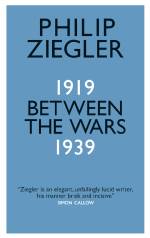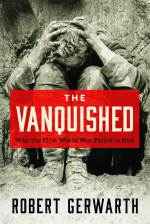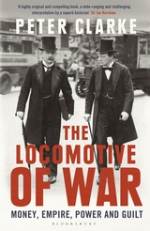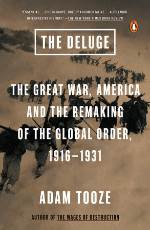- Peter Clarke, The Locomotive of War: Money, Empire, Power and Guilt, Bloomsbury, 2017.
- Robert Gerwarth, The Vanquished: Why the First World War Failed to End, Farrar, Straus and Giroux, 2016.
- Adam Tooze, The Deluge: The Great War, America and the Remaking of the Global Order, 1916-1931, Penguin Random House, 2014.
- Philip Ziegler, Between the Wars: 1919-1939, MacLeHose Press, 2016.
NEW YORK – Many now fear that we are witnessing the disintegration of the liberal international order, which has for decades ensured peace and prosperity in the West and many other parts of the world. That order was established after World War II, but it is worth remembering that its origins lie in the period following World War I.
WWI was a staggering conflagration with far-reaching consequences. Beginning as a confrontation between the Triple Entente – France, the United Kingdom, and Russia – and the Central Powers of Germany and Austria-Hungary, the war quickly engulfed all of Europe, with the exception of Spain, the Netherlands, Switzerland, and Scandinavia. In time, it dragged in the Ottoman Empire, Japan, the United States, and various members of the British Commonwealth. And, eventually, its impact was felt as far afield as Latin America and Asia.
Needless to say, WWI was immensely destructive: approximately ten million people died, and perhaps three times as many were injured. By 1918, Europe was shattered, exhausted, and demoralized. And just as the war was ending, a global influenza pandemic struck, eventually killing perhaps 50 million more people. The world that had existed before the war was gone forever.
Worse, the war’s end brought only continued disorder. Though WWI demolished Europe’s old order, it did not lay the foundation for a new one. The interwar period is thus best understood as an interregnum. Historically occurring between the reign of one monarch and his or her successor, such periods have often been unstable and violent, owing to the lack of strong, legitimate political leadership.
From a contemporary perspective, “interregnum” simply refers to a period in which an old order has crumbled and a new one has not yet taken its place. As in the past, such periods tend to be dangerous and disordered. Or, as the Marxist philosopher Antonio Gramsci put it in his Prison Notebooks, when “the old is dying and the new cannot be born … a great variety of morbid symptoms appear.” Because we may well be living through an interregnum today, we should consider what a number of recent books tell us about the last one.
BORN IN BLOOD
Before WWI, monarchical dictatorships and empires dominated Europe. But the war brought those systems crashing down, effectively destroying Europe’s political foundations. Between 1917 and 1920, a wave of democratization eliminated monarchies in Russia, Germany, and Austro-Hungary, and cleared away the remaining hindrances to democracy in other parts of Europe. Yet the era of monarchical dictatorship did not give way to a new era of democratic stability. Instead, communists, anarchists, fascists, authoritarians, and democrats battled to determine Europe’s fate throughout the interwar period.
 British historian Philip Ziegler’s Between the Wars: 1919-1939 sketches the resulting political turmoil. In Germany, the new Weimar Republic was plagued by political assassinations and violent right- and left-wing uprisings. Italy experienced two years of urban and rural chaos – which came to be known as the Biennio Rosso (“two red years”) – as well as armed conflicts between left- and right-wing militias.
British historian Philip Ziegler’s Between the Wars: 1919-1939 sketches the resulting political turmoil. In Germany, the new Weimar Republic was plagued by political assassinations and violent right- and left-wing uprisings. Italy experienced two years of urban and rural chaos – which came to be known as the Biennio Rosso (“two red years”) – as well as armed conflicts between left- and right-wing militias.
Spain also suffered through a period of civil unrest – known as the trienio bolchevique (Bolshevik Triennium) – and its Second Republic was riven by anarchist insurrections, assassinations, church burnings, and other forms of violence. In the French Third Republic, communists and right-wing extremists staged protests and street brawls. And even Britain, the most stable of Europe’s major powers during this period, experienced growing class conflict, including a general strike in 1926.
The end of Europe’s empires unleashed widespread violence, as Robert Gerwarth of University College Dublin skillfully chronicles in The Vanquished: Why the First World War Failed to End. Even before 1918, the demise of the Ottoman Empire offered a frightening preview of what imperial collapse can bring. During and after WWI, the emerging Turkish state carried out a systematic campaign of genocide and ethnic cleansing against millions of Armenians, Greeks, Assyrians, and others perceived as non-Turkish.
For both Gerwarth and Ziegler, the tragic violence of the postwar period was epitomized by the destruction of Smyrna at the hands of Mustafa Kemal Atatürk, the founder of the modern Turkish state, in 1922. In an orgy of fire, Atatürk’s nationalist forces laid waste to a prosperous, cosmopolitan city that had for centuries been a communal home to Muslims, Jews, Armenians, and Greek Orthodox Christians. Even the “peace” treaty officially ending the conflict between the Ottoman Empire and the Allies brought further suffering. Under the 1923 Treaty of Lausanne, “population exchanges” forced more than 1.2 million Christians to leave Turkey for Greece, and 400,000 Muslims to leave Greece for Turkey.
“A PEACE TO END ALL PEACE”
Likewise, the collapse of the Austro-Hungarian, German, and Russian empires led to more mayhem. In large part, this was because Europe’s former empires were carved up into new countries with borders that did not necessarily correspond to the preferences of those living within them. And, of course, the same thing happened in the Middle East, where the 1916 Sykes-Picot Agreement divided the former Ottoman territories between France and Britain. Much scorn has been heaped on that agreement in the century since. But, even if the Allies had been fully committed to guaranteeing self-determination for all peoples, it would have been difficult, if not impossible, to align state and national boundaries precisely, given the former empires’ mixed populations.
Moreover, as the books under review remind us, when Europe’s borders were redrawn, many former minority groups (including Poles, Czechs, Slovaks, Romanians, Serbs, and Croats) became majorities, and some former majority groups (Hungarians and Germans) became minorities in certain places. Not surprisingly, these status changes nurtured new resentments and generated further conflict.
 At the 1919 Paris Peace Conference, the Allies made a show of addressing this problem by insisting that new countries accept “minority treaties” guaranteeing the basic rights of all citizens, regardless of ethnicity, religion, or language. But no effective enforcement mechanism backed up this provision, and the Allies showed little interest in policing minority rights during the interwar period. Recognizing the potential tinderbox that had been created at the conference, the British Army officer Archibald Wavell quipped that, “After the ‘war to end war,’ they seem to have been pretty successful in Paris at making a Peace to end Peace.”
At the 1919 Paris Peace Conference, the Allies made a show of addressing this problem by insisting that new countries accept “minority treaties” guaranteeing the basic rights of all citizens, regardless of ethnicity, religion, or language. But no effective enforcement mechanism backed up this provision, and the Allies showed little interest in policing minority rights during the interwar period. Recognizing the potential tinderbox that had been created at the conference, the British Army officer Archibald Wavell quipped that, “After the ‘war to end war,’ they seem to have been pretty successful in Paris at making a Peace to end Peace.”
In the event, Wavell’s prediction was soon borne out. Many of the newly formed countries – Czechoslovakia, Yugoslavia (initially the “State of Slovenes, Croats, and Serbs”), Poland, Lithuania, Romania, Estonia – quickly became embroiled in civil and international conflicts. And the previous empires’ successor states did not fare much better. Germany was forced to give up 25,000 square miles of territory containing more than seven million people, thus “stranding” substantial German minorities in new “foreign” countries and feeding a revanchist nationalism.
Similarly, Austria was made into a rump state that encompassed little more than Vienna and its hinterlands, excluded many of the Austro-Hungarian Empire’s German speakers, and was not allowed to join Germany, despite its clear desire to do so. As might have been expected, it, too, experienced domestic conflict and the rise of a pan-German nationalist movement.
Hungary was also downsized substantially. A short-lived communist dictatorship, accompanied by war with its neighbors, gave way to an even more vicious authoritarian regime. To this day, the fact that the former Kingdom of Hungary (one of the two component states of the Austro-Hungarian Empire) lost two-thirds of its territory and three-fifths of its population still provides fodder for nationalists like Hungarian Prime Minister Viktor Orbán.
Last but not least, the Soviet Union confronted civil war and conflicts with Poland and the Western Allies soon after its formation. More than three million people perished in the fighting, and another two million died in the great famine of 1921-1922, which had been sparked by years of war and consecutive droughts. Surveying Europe’s post-WWI wreckage, Gerwarth concludes that “not since the Thirty Years’ War of the seventeenth century had a series of interconnected wars and civil wars” generated such death and destruction. “‘Postwar’ Europe between the official end of the Great War in 1918 and the Treaty of Lausanne in July 1923,” he writes, “was the most violent place on the planet.”
ECONOMIC RUINS
In addition to destroying Europe’s political systems, WWI demolished its economic foundations. The pre-war era had been one of increasing trade and globalization. But, after 1918, trade and other indicators of openness failed to return to their pre-war levels, and protectionism and beggar-thy-neighbor policies became increasingly prevalent. The war also effectively ended the pre-war gold standard; and with no new international monetary order emerging to take its place, monetary instability became the norm.
The most dramatic manifestation of this instability was the unprecedented hyperinflation that hit many countries. The postwar spike in prices had many causes, but chief among them was the war’s debt financing. Most readers are probably familiar with the images of Germans pushing wheelbarrows of cash. But Germany was not alone. The Austrian and Hungarian currencies also collapsed. Other countries suffered as well. The Italian lira, for example, lost around two-thirds of its value after 1918. Banking crises, high unemployment, and other chronic problems also became endemic across many countries during the interwar years.
 In The Locomotive of War: Money, Empire, Power and Guilt, British historian Peter Clarke describes the effort championed by John Maynard Keynes to replace Europe’s old economic order. Clarke’s title provides a fitting metaphor for this period of economic history. It borrows from the apocryphal observation by Leon Trotsky that war has the ability to push history onto new “tracks.” The problem, of course, is that a train that has come off its tracks cannot always be hoisted onto new ones.
In The Locomotive of War: Money, Empire, Power and Guilt, British historian Peter Clarke describes the effort championed by John Maynard Keynes to replace Europe’s old economic order. Clarke’s title provides a fitting metaphor for this period of economic history. It borrows from the apocryphal observation by Leon Trotsky that war has the ability to push history onto new “tracks.” The problem, of course, is that a train that has come off its tracks cannot always be hoisted onto new ones.
According to Clarke, Keynes understood that the “general principles upon which the pre-1914 economic order operated no longer applied.” He concluded that for Europe to achieve growth and stability once again, it would need a new interpretation of how capitalism works. In particular, Keynes argued for a new relationship between governments and markets, based on the recognition that the latter are “inherently unstable,” and that the former must sometimes intervene to prevent economic crises and high unemployment.
Despite his prolific writing and advocacy, Keynes’s proposals for a new economic order were not taken up during the interwar years. As a result, Clarke notes, widespread suffering and instability continued, culminating in the economic and political tragedy of the Great Depression. Some of the only countries spared were in Scandinavia, where native economists had developed arguments similar to Keynes’s and convinced social democratic parties to implement them. Another, albeit lesser, exception was the US under Franklin D. Roosevelt’s New Deal.
THE UNPREPARED HEGEMON
For more on the crucial role played by the US in the interwar tragedy, we can turn to Columbia University historian Adam Tooze’s provocative The Deluge: The Great War, America and the Remaking of the Global Order, 1916-1931. Tooze, like Clarke, uses his book’s title to convey the transformative impact of the war. It reprises British statesman David Lloyd George’s observation, in 1915, that the war was “a deluge … a convulsion of Nature … a cyclone … an earthquake which is upheaving the very rocks of European life.”
 Tooze focuses on two common explanations of why a stable new order did not emerge during the interwar period. The first holds that a “corrupt” old Europe – particularly British and French “imperialists” – was unwilling or unable to recognize the need for radical change. Instead, the victors of WWI insisted on a selfish and short-sighted “bad peace” that was bound to collapse. The second explanation – what Tooze calls the “crisis of hegemony” narrative – blames a naive and politically inept President Woodrow Wilson and selfish, myopic isolationists for America’s failure to assume a global leadership role after the war.
Tooze focuses on two common explanations of why a stable new order did not emerge during the interwar period. The first holds that a “corrupt” old Europe – particularly British and French “imperialists” – was unwilling or unable to recognize the need for radical change. Instead, the victors of WWI insisted on a selfish and short-sighted “bad peace” that was bound to collapse. The second explanation – what Tooze calls the “crisis of hegemony” narrative – blames a naive and politically inept President Woodrow Wilson and selfish, myopic isolationists for America’s failure to assume a global leadership role after the war.
But according to Tooze, neither explanation grapples fully with the war’s radical restructuring of power relations. By 1918, France was no longer a “power of global rank,” and even the mighty British Empire had been eclipsed by the US. In 1916, US economic output overtook that of Great Britain and its colonies. And by the end of the war, America had emerged with a global pre-eminence “so overwhelming” that many asked if a “universal, world-encompassing empire” might be possible once again – a question, Tooze notes, that has since been “expelled from the history of Europe.”

Exclusive insights. Every week. For less than $1.
Even so, a newly empowered America did not become a force for stability; on the contrary, it generated still more turmoil around the world. One reason for this, Tooze argues, is that “the looming potential” of the US – the prospect of “the future dominance of American capitalist democracy” – frightened other powers, “impelling Hitler, Stalin, the Italian Fascists and their Japanese counterparts to…radical action.” But the more fundamental problem, Tooze contends, was that during the interwar years, the US lacked a state capable of translating its power into a “grand strategy” for remaking the world in its own image. America’s failure to lead resulted not from Wilson’s flaws or the influence of irresponsible isolationists, but from a “mismatch” between the “unprecedented international challenges” of the era and the “constrained capacities” of the US federal government at the time.
Indeed, by the early twentieth century, the US had become “a byword for urban graft, mismanagement and greed-filled politics,” such that Wilson himself looked to Germany as the model of a “modern efficient” state. To be sure, Wilson had begun introducing reforms before the war, which expanded the US government’s power and reach; but, in 1918, America was still hamstrung by a “federal government that was a vestigial thing, certainly by comparison to the ‘big government’ that would act so effectively as the anchor of global hegemony after 1945.” What the interwar period made clear, then, was that American power alone could not re-stabilize the world. That power needed to be wielded by a more capable state that was willing to take on a transformative role.
TOWARD ANOTHER INTERREGNUM?
The tragedy of the interwar years thus lies in the conflict between the new “central role” of the US in world politics and the “frailty of the American state,” which left it incapable of answering the call of history. Tooze laments that by 1918, the US government’s failings were “no longer [merely] a domestic drama”; America’s weakness now had “global ramifications.”
Nevertheless, by the end of WWII, both American power and the US government’s reach and capacity had expanded dramatically, owing to the New Deal and the war effort itself. For these and other reasons, the US of 1945 was able to do what the US of 1918 could not: construct a new international order that would ensure peace, prosperity, and stability for capitalist democracies around the world, starting in Western Europe.
Today, the US-led postwar order may be crumbling. But, as in the interwar period, the reason is not so much an absence of American power or the rise of revisionist opponents such as Russia and China, but rather a lack of US will, vision, and state capacity. Over the past few decades, sustained attacks on “big government,” misadventures in Iraq and Afghanistan, rising inequality, declining social mobility, and political corruption have divided American society and weakened the US state.
As was the case after 1918, sustaining a stable liberal order is proving immensely difficult in the absence of US leadership. We may not be in the midst of a new interregnum quite yet, given that the post-WWII system has not decayed as much as Europe’s pre-WWI system had by 1918. But if the US stays the course that President Donald Trump has charted for it, the world could soon find itself plunging into disorder and systemic violence once again.



